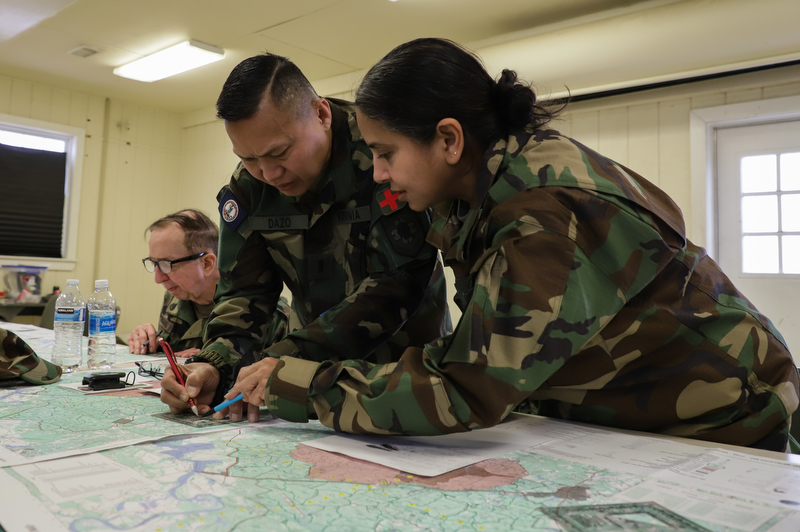VDF trains at Fort Barfoot to support evolving mission sets

FORT BARFOOT, Va. — Members of the all-volunteer Virginia Defense Force convened March 14-16, 2025, at Fort Barfoot, Virginia, for a multiple unit training assembly that supports the VDF’s evolving role as a force multiplier for the Virginia National Guard.
The three-day event convened more than 100 VDF personnel from across the commonwealth for classroom and hands-on training focused on officer and noncommissioned officer professional development, logistics distribution, communications, land navigation, cyber defense and wellness.
“Over the past few state active duty emergencies, our mission sets have evolved,” said Maj. (Va.) Michael Perini, the VDF’s G3 operations and training officer. “Our training therefore has progressed into a conglomeration of our mission sets. Merge that understanding with communication training and NCO and officer development, and we additionally present a holistic provision for the state active duty cycle in which the VDF supports the Virginia National Guard.”
The training sessions were prepared and led by the VDF Headquarters instructional group and designated instructors from Force Headquarters Major Subordinate Commands.
On Friday evening, company-grade officers took part in leadership development training designed to enhance flexibility, mentorship, and unit cohesiveness. Other personnel spent Saturday morning refining their skills in close-order formation.
“Saturday’s agenda began with drill and ceremony on the parade grounds before VDF members were dispersed into their individual training units,” said Command Sgt. Maj. (Va.) Christopher Howlett.
The MUTA brought together units to strengthen the skill sets needed to assist the VNG. The VDF has provided important administrative and logistics support to the VNG as part of the commonwealth’s response to recent weather events and power outages.
From Feb. 9-24, the VDF deployed nearly 25 personnel across five teams, each with an administrative specialist and logistics specialist, to embed with VNG Soldiers and Airmen.
The teams rotated to 11 facilities across Virginia during the 16-day operation, from the Eastern Shore to the Appalachian Mountains, to provide administrative and logistics support. The teams safely drove more than 6,500 miles, managed cargo valued at approximately $47,000, and processed nearly 150 VNG Soldiers and Airmen onto state active duty.
VDF logistics specialists delivered chainsaws and protective equipment, coordinated for lodging and meal support at the staging locations, and sourced supplies locally as needed. Additionally, VDF personnel provided communication support at VNG’s Joint Force Headquarters in Richmond.
The training assembly also focused on expanding the number of personnel qualified in emergency communications, a core area of VDF expertise. Seven VDF members passed the Federal Communication Commission amateur radio license exam administered by the Virginia Defense Force Radio Group, qualifying them for the entry-level Technician class license. These individuals are now authorized to wear the “Technician” tab on their uniforms.
“The FCC Technician license exam includes necessary parameters, operating systems, and electronics theory,” said Perini. “High frequency radio expertise and application are essential elements of communication aid offered to the Virginia National Guard.”
Warrant Officer 1 (Va.) Kenneth Taylor and 1st Lt. (Va.) Chris Connor planned and executed land navigation training that started with coursework and concluded with field exercises.
“Land navigation is a perishable skill, and one that can offer immediate results once participants get out in the field,” said Taylor. “In addition to providing capabilities that support our Virginia National Guard counterparts, it’s a useful proficiency for our members to develop.”
VDF personnel assigned to the 31st Cyber Battalion conducted classroom training exercises to hone their skills in defensive cyber operations. The mission of the 31st Cyber Battalion is to enhance the cybersecurity of the commonwealth by serving as a force multiplier for the Virginia Department of Military Affairs.
Col. (Va.) Rodney Brickell, chief of staff of the VDF, presented individual awards to VDF personnel and noted the importance of individual readiness, teamwork, and dedication to mission.
Officer Candidate Roman Ramirez was promoted to second lieutenant after completing the year-long VDF Officer Candidate School program. Second Lt. (Va.) Ramirez will be assigned to the Operations Section in the 21st Liaison Battalion.
In his Winter 2025 Update message to VDF members ahead of the MUTA, Brig. Gen. (Va.) Rich Diddams, Commander of the VDF, said, “Always keep in mind the importance of training hard, adhering to the highest standards and living with honor and courage. These are not just ideals: they are a way of life. The success of our mission depends on each of us embodying these principles every day, not just when it’s easy, but especially when it’s hard.”
As part of Diddams’ emphasis on wellness, VDF personnel participated in a resiliency ruck march to conclude Saturday’s activities.
The VDF is authorized by Title 44 of the Code of Virginia as the all-volunteer reserve of the Virginia National Guard, and it serves as a force multiplier integrated into all Guard domestic operations. The VDF reports to the Adjutant General of Virginia as part of the Virginia Department of Military Affairs along with the Virginia Army National Guard and Virginia Air National Guard. Members of the VDF volunteer their time for training and are only paid when called to duty by an authorization from the Governor of Virginia.

